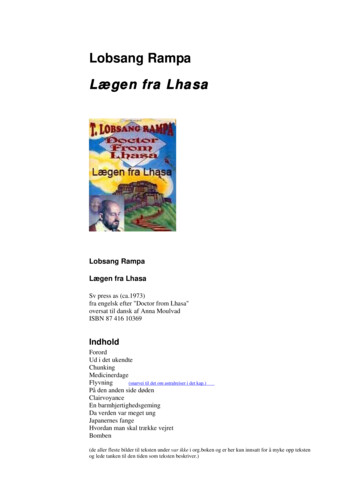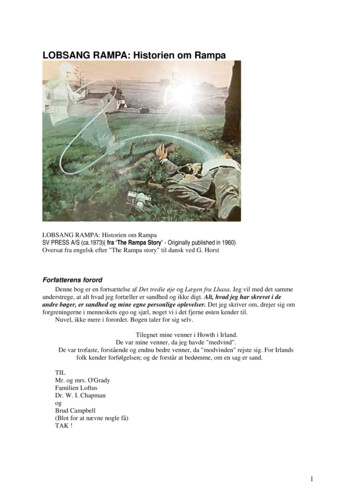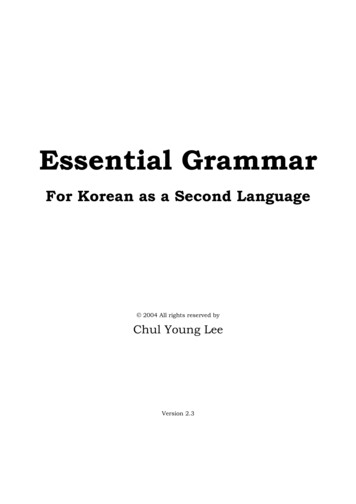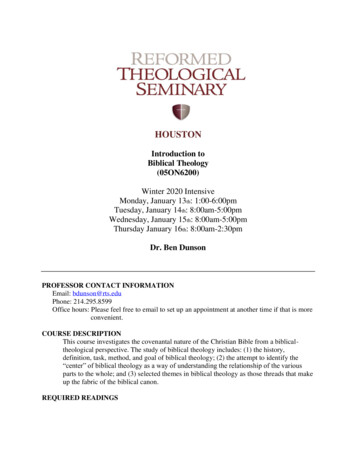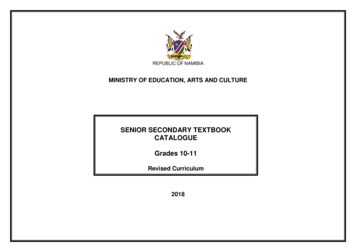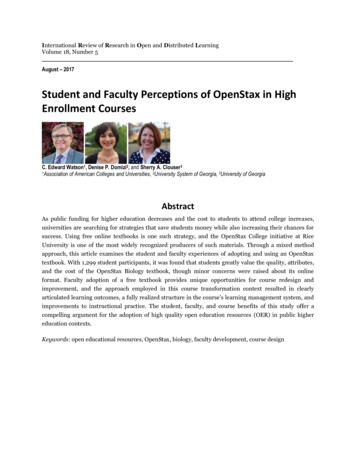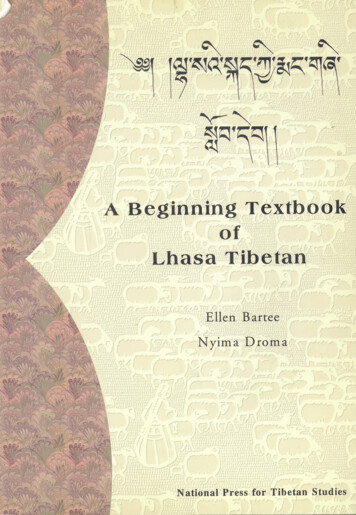
Transcription
A Beginning Textbook of Lhasa Tibetan
C\C\C\-y A Beginning Textbook of Lhasa TibetanEllen BarteeNyima DromaNational Press for Tibetan Studies2000
Cataloging in Publication DataBartee, EllenNyima DromaA Beginning Textbook of Lhasa TibetanEdited by Nganwan Pincuo, designed by Li JianxiongIncludes glossary1. Language, Tibetan, Elementary2. Linguistics, Tibeto-BurmanISBN 7-80057-430-X/G.19First printed in 1999 by the Summer Institute of Linguistics.Revised version reprinted in 2000 by National Press for Tibetan studies.No part of this book may be reproduced in any form, by print, photoprint,microfilm, or any other means, except for personal use.
eFourviiThe Tibetan alphabetPrefixes and suffixesSuperscribed and subjoined lettersWhat is this?9131723Lesson FiveWhat nationality are you?31Lesson SixWhere are you from?37Lesson SevenTell me about yourself and your family45Lesson EightWhere are you going? What do you do?55Lesson Ninehonorifics and 5] Q5)What time is it?67NOLesson TenEating and drinking79Lesson ElevenEveryday activities89Lesson TwelveMaking plans and setting a date95Lesson Thirteenreview of verbs and 1 / Going to Lhasa C l* q 105 Lesson Fourteen What are you doing?T l W § c c *H and the ergative markerLesson FifteenArriving in Lhasav115 129
Lesson SixteenTibetan tea3*1 R 139 Lesson Seventeen Visiting a doctor SLesson Eighteen\3147NOAt the store,155adjective forms ( 5 ), comparative marker and the question particle V:V:Answers for practice work.A brief look at Tibetan GrammarA note on VerbalizersHonorifics in Lhasa TibetanA brief overview of some important pronunciationpointsTibetan-English Glossary.English-Tibetan GlossaryBibliographyVI163181193197207211241267
PREFACEThe goal of this textbook is to teach the student how to speak the Lhasavariety of Tibetan. We have assumed a general familiarity with thewriting system and have only included three chapters- as a basic overviewof the alphabet and rules of spelling 1 . Because the starting point of thisbook is very simple, it provides an excellent opportunity for the studentto immediately rely on Tibetan script rather than romanized script. This,we believe, will help to immerse the student in Tibetan. Hence, n oromanized script is provided and the student is encouraged to practicewriting as well as speaking every day. However, this textbook can still beused for those who are learning the Tibetan writing system concurrent tospeaking.This is not a grammar book, nor does it seek to analyze Tibetan from alinguistic perspective. We have sought to provide easy explanationswithout oversimplifying to the point of meaninglessness. In order to dothis, vocabulary and grammar are controlled and introduced at an'digestible' rate. Some structures are not fully explained initially, andcomplex examples are avoided, but enough explanation is provided forthe student to be able to master the conversations being studied. As thelessons progress, complexity will increase.We have attempted to limit the vocabulary and structures to the Centraldialect of Tibetan, particularly that spoken in and around Lhasa. In orderto truly represent Lhasa speech, polite terms (honorifics) must be learned.This sometimes makes it difficult for the beginner, but we have tried toinclude what is necessary without overloading the student. Becausewritten and spoken Tibetan can be quite different, sometimes thepronunciation does not correspond to the written form. We point outsuch instances to the student and give phonetic transcription to help thestudent with Lhasa pronunciation.The core lessons in this textbook contain a limited number of vocabularyitems (about 700). Most students will find this a sufficient start as n o r m a leveryday contact will also bring opportunities to learn new words. In theprocess of acquiring vocabulary, it is important to do so in context and wehave tried to contextualize the vocabulary included in this book.Depending on the student's speed, we recommend that two to four classhours be spent on each lesson for a duration of roughly 18 weeks.1There are several textbooks that give a good overview of the writing system. For thosewho read Chinese, look at zangiuen pinyin jiaocai (bod.yig.gi sgra.sbyor slob.deb) and thefirst chapter of lasa konyu (lha.sa'i kha skad klog.deb) which provides an overview ofall the different rules of spelling. For English readers, try the first chapter of ModernTibetan Language, Vol I by Thonden Lobsang.Vll
This book is accompanied by 2 cassettes that were recorded by threespeakers from Lhasa city and one speaker from Lhokar. Before beginninga new lesson, whether studying with a tutor or in a classroom, it isimportant to listen to the tape a few times without attempting to say anyof the new words or phrases. This will help fix the proper pronunciationand rhythm of the language in the mind of the learner before bad habitsare subconsciously formed.The appendices include several sections that we think will be useful:answers to all the practice work given in each lesson (Appendix I); a shortintroduction to Tibetan grammar that covers some of the most difficultconstructions the student will encounter when first learning Tibetan(Appendix II); a general overview of verbalizers in Tibetan (Appendix III);a paper on honorific usage in LT (Appendix IV) and a very brief reminderof some spelling rules that affect pronunciation (Appendix V).Inaddition, there are both Tibetan-English and English-Tibetan glossaries tohelp the student easily look up words as well as an annotatedbibliography to give the students areas for further study.Finally, we would like to thank the many people who helped check thisbook a n d / o r who provided valuable advice and help as we were writingit. Thanks to Ken Hugoniot, Ngawang Pintsok, Geoff Bailey, Yangchen D.Tsatultsang, and Professor Hu Tan for their corrections, suggestions andideas. The Tibetan in this book was first produced using Wylie Edit whichwas developed by Chet Wood. Tashi Tsering, computer whiz, introduceda few changes in the font and managed all the technical difficulties.Tsering Thar kindly allowed us to use his Macintosh while working o nthe book at the Tibetan Research Center in Beijing.We hope this book is helpful to you.Ellen BarteeNyima DromaSeptember, 1998Revised in September, 2000viii
*3 3 LESSON ONEIn this lesson, you will learn the thirty Tibetan root letters and four vowel diacritics.The Tibetan Alphabet consists of 30 root letters and four vowels. Eachroot letter has an inherent 'a' sound. When the vowels are added aboveor below the root letter, they change the 'a' (as in 'pot') to either 'e' (as in'ray'), T (as in 'bee'), 'o' (as in 'so'), or 'u' (as in 'shoe'). ' W 3 THE THIRTY ROOT LETTERSThe 30 letters can be roughly subdivided into either high or low register(low register letters are underlined) and with or without aspiration(aspirated letters are written with an 'h'). Listen carefully and repeat afterthe speaker on the tape.T kaP3kha*lkha nga chaE: chayr ra ? ta3*\tha naCiP**4 phaq pha mavtsa&i 1 wa sha3 saq a raO] la *? haGS ajathatshatshasha V sa9
H ' l l WRITING ORDERIt is very important to write each letter in the order and direction that istypically used by Tibetans. The general direction is left to write and top tobottom. In the chart below, each letter is written one stroke at a time foryou. (calligraphy by 1)."-"r T XI-rr*r n"J-3-5"'I'1 *\"VrrF rJ\KifrRq- r rFT g-s 'r"r 2 cP SI"T a;T 1-"1 r 5 3 tf 1 r*"1FrrTro.* "c\U-0-P«fl1r* 10p CIcq «H * *, ' * « JTp""J36 a5* V H"\ NU0, 01foOs cqrK; r(5t3\ u\ \/§ \
c\ s p q j THE FOUR VOWELS 1Each vowel has a name based on its shape 2 . The chart below indicateseach vowel as seen in combination with the root letter :us'curve' TnFll l BSW q*qjqgcq3 'foot hook''upright''nose horns'SPELLING STYLESyllables in Tibetan can be as simple as one root letter (for example, T)or as complex as a combination of seven elements (one of which is avowel). Each syllable is spelled in a fixed manner. Learning how to spellaloud is crucial for remembering how to spell words on paper. The basicorder is left to right until reaching the root letter, then top to down, andcontinuing left to right until the syllable (or word) is completed. Listencarefully to the tape several times 3 and then repeat the following syllablesafter the speaker (you will have to stop the tape):Root letter*JVowel\3c; q 'qWordMeaning 'person'5'to cry' 'that' 'yoghurt'Vq1Of course, there are many more vowel sounds in Tibetan, but only four vowel glyphs.From The Classical Tibetan Language by Stephan Beyer, p. 45.3Research has shown that students who first listen to a native speaker many times beforeattempting to speak, tend to have better pronunciation and intonation than those who donot. Part of the reason for this is that the student can internalize the correct pronunciationand rythym of the language before falling into bad habits of production. In addition, beingable to first listen reduces the potential stress of language learning that some students mayencounter.211
'fcPRACTICEA. Listen at least three times to the alphabet before attempting to repeatafter the speaker.B. Listen to the tape and circle the letter you hear.l f l l2.* 3 * 3. 4.«4 «3 *15. 56. # 7.1*1 aC. Listen to the tape and write the syllables that you hear spelled.1.2.3.4.5.6.7.8. Y' C \V' T T T ' I DO YOU KNOW?A person travelling across Tibet will not only notice unique culturalfeatures that distinguish each area, but will also note unique linguisticfeatures. Traditionally, Tibet is divided into three broad dialect groupings:Central (which includes Lhasa Tibetan), Khams and Amdo. Within eachof these, there are many smaller dialect subgroups. There can be greatdifferences among these dialects, to the extent that some are mutuallyunintelligible. However, literate Tibetans all over Tibet use the samewritten form and can read the same documents. The reading style willvary according to the local dialect and the manner in which they havebeen taught to read. A person from Amdo for example, most likely willnot distinguish any tones in their reading, unlike a person from Lhasa.The person from Lhasa, on the other hand, will not read any- initialconsonant clusters, unlike the person from Amdo. So even though theymay not understand each other when speaking, literate Tibetans canunderstand each other through writing.12
gq' lLESSON TWOIn this lesson, you will learn the possible suffixes and prefixes in Tibetan a f § * FIRST SUFFIXESTen of the root letters can also function as suffixes. These are 1 &] Q, cij a n c j e w \ briefly discuss some of the consequences ofpronunciation when these suffixes follow a root letter.I. Tonal changesGenerally, the suffix 1 causes a high tone to become high-falling and alow-rising tone to become low-rising-falling. Compare the followingsyllables:II. Final consonantcare pronounced at the end of the syllable. For 'barley beer' 'and' 'mother' (honorific)The suffixes andexample:III. Vowel changesA. The suffixes *\ &\ and not only make the vowel of the root letterslightly longer, but also change it in the following ways:a — e (as in English bet)o — 0 (as in French seul)u — Y (as in German ftillen)In addition, causes the vowel to become nasalized. When root lettersinclude the vowels 'i' or Je', there is no pronunciation change. Listen tothe following examples on the tape:13
" -NO *WX3«4'y- - - %VNONO 3&9- . 3 goj *toB. The suffix is pronounced as an unreleased 'p'at the end of thesyllable (that is, your mouth should stay closed after pronouncing it).When it follows an open vowel, the 'a' changes to a schwa (like the 'u' inthe English word 'cup')4. 'needle' 'book' q'father' (honorific)C. The suffixes and cause the syllable to lengthen. Sometimes adds a slight Y sound5: ' f l 'up' 'photo' T*"to be happy'SECOND SUFFIXThe suffix also functions as a 'second suffix'and can occur after fourroot letters: 1 and . Listen to the pronunciation differences:4When is the last syllable in a word, it is typically pronounced as 'wa'.5This is especially noticeable with older speakers.14
pajpa q OIOj ' PREFIXESThere are five prefixes that can occur before a variety of root letters:PrefixRoot letters q ci jq c:JJThe pronunciation of some root letters is affected by the prefix. When z ? 3 U a r e prefixed, they change from low to high tone. When "1 are prefixed they change from being aspirated to beingunaspirated. When ) * are prefixed, their pronunciation doesnot change.SrT§T*F S P E L L I N G STYLEEach prefix is pronounced with -wo/-o before the root letter and then thefinally the whole syllable. For example: yak1T l 1 «\ *\'to be happy'T l "1 a'to send out' c15
'face'* J ' n\ 3 * c * 'to land' W NOTE At first, it can be difficult to know which letter is the root letter.Here are a few simple ways to recognize the root letter to get you started.The root letter is almost always the one which has a vowel or anotherletter above or below it. If there are two letters, then the first letter mustbe the root letter. If there are four letters, then the second letter must bethe root letter. In most three letter syllables, the second letter is the rootletter. If the second letter is one of the suffixes or and isfollowed by , then the first letter is the root letter. 'f PRACTICEA. Write each word as you would verbally spell it1. 32. *3. * 4. 5. 6. 7. T 8 .WB. Circle the root letter in each of the following words1. *12. 3. W 4. a p qv ' c\5#fujaw6tfj 7 qv' T H ' ' lDO YOU KNOW?In Written Tibetan a small dot called * q I occurs between syllables, butthere is no indication of word boundaries. Since many Tibetan words arepolysyllabic, it can be difficult at first to recognize word breaks. Inaddition, there is only one punctuation mark ( ) called *V It can be usedat the end of a sentence, a paragraph, or a book. It can also tell the readerwhere to pause or where to take a breath. Another convention commonlyused is called uJqT*IZT ( %3*3 ) and is used at the beginning of an articleor book.16
gq-a ' w iLESSON THREEIn this lesson, we will finish our overview of the Tibetan alphabet and spelling.So far, we have talked about prefixes, suffixes and vowels that can alloccur in one syllable. In addition, there are superfixes and subfixes thatcan go above and below the root letter. As few as one, and as many asseven different elements can occur in one syllable. 3 SUPERFIXED LETTERSThree letters and can function as superfixes. The* rules ofpronunciation are the same as those for the prefixes with a fewexceptions. When is superfixed to *?, the result is lha. Like the vowels,these letters have names and can occur with the following root letters:SuperfixName *]SJOJoi j3j *r *i3jRoot letter occurs with 'TSJT SPELLING STYLEThe correct spelling order is first the superfixed letter, then the root withthe suffix 1 , then the whole syllable (the other elements such asprefixes and suffixes follow the order explained in the previous chapters): q qj 043% q Uj 1njS-q Ujq§oj5' 91*r«5* 1ST*17
NOTE Prefixes and superfixes can affect adjacent syllables within words.For example, when a syllable does not have a coda, that is, no finalconsonant, it may take the prefix of the following syllable as its coda.Thus, most Lhasans pronounce (from the examples above) astap.ta, not ta.ta. In addition, the prefix and the superfix are oftenpronounced as a final nasal consonant in the previous syllable. Thus aword like ('now') is pronounced than.ta, not tha.ta. As in thespelling systems of most languages, however, there are exceptions.r l '33 SUBJOINED LETTERSThere are four letters, , which can function as subjoined letters.Unlike most of the other letters three of these letters change their shapedrastically 6 . These letters can occur with the following root letters:LetterU Shape Nameurqtp*! -J Tq a]njorq uj H \ Root letters7T p nj q q q *]TTj qpquj.TT u qj; q z j j P d S g O J With the exception of 1 , which does not change the pronunciation ofthe root letter it occurs with, the subjoined letters greatly affect thepronunciation. When is subjoined to P or 1, they are pronounced with a 'y'sound (kya, khya, khya). When it is subjoined to or , theyare pronounced just like and . When is subjoined to *? P 1 or , they are pronouncedwith an 'tr' sound. Aspiration and tone do not change in the root6The superfix is changed slightly as well.18
letter. Thus and are all pronounced as high and unaspiratedtra. P and are pronounced as high and aspirated thru and P 1 and are all pronounced as low, aspirated thru. When J is subjoined to or , all but one of the root letters ispronounced la with a high tone. Thus a] n] 3 etc., are all pronouncedla. The one exception is aj which is pronounced ta7. ' S H ' SPELLING STYLEThe subjoined letters are read after the root letter in the manner shownbelow. The final combination is the completed syllable:qUfq a] 9f3urq U] 0p C S] F3qSl'i 3*lOl'q nj ?aNOf 0SI*ian ' I p PRACTICEA. Circle the syllable that is a different sound from the others.i. a iftsi2. 21 S53.«3g3B. Using a dictionary, look up the following words and write down thedefinitions (a dictionary enters words according to their root letters)7Some speakers first pronounce a slight nasal consonant before the root consonant. This istrue for roots which have or as prefixes and as a subfix.19
2. SFf 3.4. ' ' T T ' IDO YOU KNOW?Tibetans love calligraphy and place high value on its history and writtenexpression. At the inception of written Tibetan, there were two mainstyles of writing: 5 * and 5 which are still used today. The font-\used in most publications, including this book, is 5 * . During theTubo Dynasty, eight styles of 5 * and two kinds of 5 \ weredeveloped. Eventually as many as a hundred different styles of writingwere developed, each with its own unique style. In Modern Tibet, fourstyles are mainly used. Children usually begin learning how to write&*\ *l. Most Tibetans in Central Tibet use g T 5 and for.correspondence and everyday business, while those from Amdo andKhams tend to use 5 * . *is used throughout Tibet, but probablyused more in Lhasa than elsewhere. Here are examples of these fourscripts (calligraphy by * )20
g-aajl651qg'« io]«c«l%m p&wagp\-iw\ v sy N V 21
22
- LESSON FOURIn this lesson, you will learn the linking verb *f\, its negative ' and the question formDIALOGUE ONEIja]- - *roF lJf '«J ' : Migmar:Nyima:Migmar:Nyima:Migmar:Nyima:Nyima-la, what is this?That is a pen. Migmar-la, what is this?That is a textbook. What is this?That is a chair. What is this?That is a table.Oh. * T * j NEW WORDS1. a F * lesson/class13. ' first, ordinal number82. that14. , q lpen8 is the ordinal number for "I'S"!; all other numbers form the ordinals by adding tothe cardinal form, i.e. " j ! * 'second', ' 'third', etc.23
3. this15. polite suffix attached tonames and titles4. book16.nF qtextbook5. * F ' * Hchair17. 1' desk, table6. is18. negative, not7. 1 what (question word) 19. 8.W /GS'0 /ah,question particle20. ' Hpencildictionary9. word21. T * * 10.T 'qnew22. % CTT1) paper11. ' Mars, a person's name12. 9 The sun, a person's nameGRAMMARI. Dialogue one is based on two grammatical patterns:A. Interrogative sentence (content question 9 )this/that iAquestion wordT* verb . Declarative sentence (simple sentence)this/that Noun A verb II. Numbers 1-10 Numbers come after the nouns they modify (just theopposite from English)! After looking at numbers one to ten, fill in theblanks according to the pictures below:1. W9one 6 . 5*1sixA content question (or information question) requires an answer other than yes/no or achoice of one of two possibilities (either/or).24
2. "19**two3.three 8.4. 7.qc sevei eightX3four9. nineNOfive5.H10. §tenhfo 'IH'11! SAY IT RIGHT TS is pronounced THin spoken Lhasa speech. Inquestions, is pronounced like the 'e' [e] in 'red', while in statements, itis pronounced like the 'a' [e] in 'ray'. Listen closely to the tape as well as toyour teacher.DIALOGUE TWO 1 %S' IMigmar:Nyima:Migmar:Nyima:Migmar:Nyima-la, Is this a pen?Yes, that is a pen. Is this a textbook?No, that is not a textbook. That is a dictionary.Oh. Is this paper?Yes, That is paper.GRAMMARI. The negative is placed between the noun and the verb to make anegative sentence:25
q\ A o\q' q' ' 1This/that is not a textbook'II. Yes/no questions10 are formed by adding as the final constituent inthe sentence. The answer can be a full sentence or simply 'is' or 'is not':Q: *\'A'A: c c aF ' ' 'Is this/that a textbook?' 'Yes, it is' (literally 'is')*J' 'No, it is not' (literally 'not is') ' ! T ' ' ' l'No, that is not a textbook'PRACTICEA. Fill in the blanks:V1. A l2. ' f l '3.T. "NT *' 1 (Question / answer)(Question)*1' 1B. Based on the first example, make four sentences about each one of thefollowing pictures11:1.a. TS'T ' 1d. 'ffl' l10Questions which require a yes or no answer.It is not important which demonstrative pronoun ('this' or 'that') is used in this exerciseas long as the student has a real context in mind.1126
Aa.b.cd.b.b.c.d.Using the new words of lesson one, form the following differentsentence types:1. Simple (declarative) sentence2. Negative sentence3. Content question interrogative sentence4. Yes/no question interrogative sentence
MEMORIZE the days of the week and numbers 1-10; listen closely and tryto imitate the pronunciation of the speaker on the tape:Days of the week 12 cx -aiSunday*j -qMondayq 3(T*Jq ' Ji Tuesdaysjga f Wednesday1\3Thursday\0zj]3 Tq' CFriday cr -qSaturdayNumbers one throueh ten: one*\ threeBlfive* twofour5*1six\3eight seven nine 33\3tenSOME USEFUL PHRASES[This section will include phrases that will be useful as you start speakingTibetan. It is best to memorize them and use them as often as you can.]12J 'r*!Thank you'5*F ,qI3FIThank you' (honorific)There are other words used for the days of the week; for example, it is also common tospeak of the days of the week in cycles of seven ( H), but you can learn those later.28
TTT ' lDO YOU KNOW?Tibetans have many ways to select names for their children. Often thenames have four syllables, but not always. One way to pick a child's nameis to use the day of the week the child was born on. For example, 9 'Sunday7 (9 means 'sun'); if a child is born on a Sunday, , a commonTibetan name, can be used (just drop the 1 ) . All the days of the week areused as names or parts of names; they also have other meanings. canbe put before the following words to form days of the week: 9 'sun'(Sunday); 5Tq 'moon' (Monday); * * l 'Mars' (Tuesday); &!Tq'Mercury' (Wednesday); 5 7 u piter' (Thursday);q' C*l Menus' (Friday); and t l 3 'Saturn'(Saturday).29
30
LESSON FIVEIn this lesson, you will learn the verb W3j as well as more about .DIALOGUE ONEA:B:A:B:Is he/she Tibetan?Ye, he/she is Tibetan.Are you Tibetan.Yes, I am Tibetan. ' jNEW WORDS1. I, me7. Tibet2.ST you (hon.)g. - l Tibetan ( V*l3.PC3rd person (hon)9. *I4. plural marker10. 3 ' ( ) girl5 . is, to be (1st person)11.36 . is, to be (non-first person 12. *\/Fman, personboyused like A/Bis q - q s probably more outside China than inside. ' is not used that much.31
GRAMMARI. In declarative sentences, is generally used with first person andis used with second and third person:c\II. * can be added to person pronouns, demonstrative pronouns andsome words14 to express plurality:c' 'we' ' 'these'ST ' 'you (plural)'S%'those'Fc' 'they'SAY IT RIGHT Vowels in syllables which are in the same word affecteach other's pronunciation. Often, the vowel in the first syllable becomesthe same as, or very close to, the vowel in the following syllable. Thus,.- * '. 5 is pronounced **. The vowel in the first syllable is affected by thevowel in the second syllable.DIALOGUE TWO14Usually those words which refer to people.32
ka:kha:ka:kha:ka:kha:Is that guy Tibetan?No, that guy is not Tibetan.Then, what nationality is he?That guy is Chinese.Oh. Is that dog his?No, That is my dog.S H NEW WORDS1. f3 China7. 3 ' 2. S ' Chinese (S'*J)8.f Y Indian.(S'Vl* )3. well then, then9. white4.1dog10. Sff%blackgenitive marker (of)11. r nationalityIndia15-catSAY IT RIGHT 3 ' ' q is often pronounced S ' 1 ' * [k'aekaira].GRAMMARI. 1 and have the same meaning and function, but is used onwords which end with vowels and "1 is used on words which end inconsonants 16 . When is added to words, the pronunciation isaffected: [a] (as in 'ah') becomes [e] (as in 'ray') and [o] becomes [0] (say'ay' with rounded lips); in addition, there is a slight lengthening of thevowel:15c[rja] [rje:]P[kho] [kh0i] 'his''my', 'mine'An alternative spelling is 5 1 which is a more common in Written Tibetan.Altogether there are five allomorphs (variations) in Written Tibetan and they aregiven in chapter three.16
( '*iq [yimi:] '(the) cat's«V* [fimi] *II. Dialogue Two includes two different ways to express possession:A.T* * pthatmyB. Udog'That is my dog'dog IisT 1'That dog is mine'thatmyisIII. In Lesson One, you learned that numbers come after the nouns theymodify. When a phrase has a noun, number and demonstrativepronoun, the order is the opposite of English:*rA.Wman threeB. book two *!that.plural'Those three men' ' 1this.plural'These two books'17IV. Suffixes in Tibetan are very productive; that is, a small number ofsuffixes have wide applications and often adding a suffix forms a newword. So far, you have learned the following irl''3i'Chinese''Tibetan'18q17person'Tibetan'Most adjectives are formed with the suffix ; when numbers fill an adjective slot, theyalso can take this suffix. This seems to be optional however and determined by how itsounds; that is, how the phrase flows, which is an important criteria in Tibetan.is q -SJis alsQthename of the Tumi' nationality in Yunnan province.34
c fcPRACTICEA. Write the Tibetan equivalent of the following English phrases.1. my book2. This is my book3. This book is mine4. That book is not mine5. that person6. That person is a male7. That person is not a Tibetan8. This book is that person's9. three dictionaries10. Those two dictionaries are his/hersB. Using "] and put the following words into correct order to makephrases or sentences as in the first example: 2. / "V. c\c\FfT f!/*)cH (V*)3 . c\ **-N v' v*4. / F 5.TTS / SF' SOME USEFUL PHRASES'I don't know/'I am sorry.'c\ /
y ' ' lDO YOU KNOW?Tibetans love pets, especially dogs and cats. But among the nomads andfarmers, dogs are more than pets — they are guard dogs. Often Tibetanswill have several dogs around their house or tent. These dogs, ormastiffs, are ferocious towards anyone they do not know. Sometimesthey are tied up, but not always, so it is always better to shout out 'hello'(B Q, n l ) from a safe distance before venturing too close.36
LESSON SIXIn this lesson, you will learn how to form questions as well as more about the genitivemarker.DIALOGUE ONE*J* ' ai* arop «qjl ' s i?'*1c' 'Si F - *J C' ' '3 't ?'*!GfO Jfal' ai*]pc-ca w j?'*!l c- ' S' lIjOj- ar j -*ql?l'OJ a:Nyima-la, Where are you from?I am from Lhasa. Where are you from?I am from Shigatse.Oh. Who is he?He is my friend.Is your friend Chinese?No, he is a foreigner. He is from Japan.Ah.g ' 'S qjp ' Jjfc- 'gar*l' p '3 ' 1&*r*i *il.3 from7. who2.T1 friend (male)8.* Japan19For Tibetans living in China, the names of countries are generally borrowed fromChinese; for those living outside of China, they are often borrowed from English.37
3. r T 3 from where4.Sf** '«1)Lhasa5. ' T SShigatse6. T1 '*Jfriend (female)9. S'S foreign (lit:'outside kingdom')10. I'S '* 1foreignerSAY IT RIGHT The choice of genitive marker * § S or - is affected bythe preceding consonant20, but they have the samemeaning; in Lhasa speech they also have the samepronunciation (* ). In the capital, W is pronounced8 [tesa].GRAMMARI. Dialogue One includes the following patterns21:A. Interrogative with WH question word22pronoun question word20Following syllables that e n d i n g orc l/ luse " ; ** * or * use 3; *}qor use 3; or open vowels, use 211st person questions and 2nd person statements are rare (probably because it is imlikelythat one would ask information about oneself or make a statement to someone aboutthemselves), but we included these to show the complete set of grammatical forms. Yourteacher may resist such forms, but they do exist in situations of joking, accusation, etc.22Questions that express who, what, when, where, why, how, and which.23In WH questions, is often used when asking a person a direct question aboutthemselves. It seems to take away some of the potential harshness of such a question.38
B. Interrogative with the question particle 1pronoun nationalityC. Statement with the postposition24pronoun place name ' / * 1 i/ V*D. Stating one's nationalitypronounnationality / 1These patterns are based on the correspondence of person with verbmarking in Tibetan. First person statements and second person questionstake the same verb form while second and third person statemen
book and/or who provided valuable advice and help as we were writing it. Thanks to Ken Hugoniot, Ngawang Pintsok, Geoff Bailey, Yangchen D. Tsatultsang, and Professor Hu Tan for their corrections, suggestions and ideas. The Tibetan in this book was first pr
